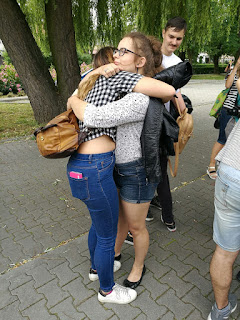20.06.2016 r.
Erasmus in Zakopane
Erasmus in Zakopane
Our guests visited Zakopane, a beautiful town which lies in
the south of Poland at the foot of the Tatra Mountains. It is the centre of
Goral culture and is known as "the winter capital of Poland". It is
popular destination for mountaineering,skiing and tourism.
We visited The Jaszczurowka Chapel which was designed by
Stanislaw Witkiewicz. It was built in 1904 and is a typical example of Zakopane
style:high stone foundation,arcades in the front,a tiny tower with a bell on
the roof,the wooden altar,stained-glass windows.
We were walking through the town's most popular
street:Krupowki. It is lined with stores,restaurants and performes.Here we
bought unique souvenirs.
Hiking is very popular in Zakopane. The walk through
Strazyska Valley was very exciting. The views were amazing.
In the evening we experienced goral culture, which is rich
in its unique styles of food,speech,architecture,music and costumes.
21.06.2016 r.
Cracow
UNESCO World
Heritage Site
One of the
oldest cities in Poland and one of the leading centres of Polish academic,
cultural and artistic life.
We visited:
St. Mary's Basilica
Brick gothic
church re-built in the 14 century. It is famous for its wooden altarpiece
carved by Wit Stwosz. On every hour, a trumpet signal-called the Hejnal
Mariacki- is played from the top of the taller of St.Mary's two towers.
Wawel Castle
The Wawel Castle is a castle residency built at the behest
of king Casimir III the Great, who reigned from 1333 to 1370. It consists of a
number of structures situated around the central courtyard.
The Wawel Castle and the Wawel Hill are the most
historically and culturally important sites in Poland. For centuries it was the
residence of the kings of Poland.
Krakow Cloth
Hall
It is one of the city's most recognizable icons. It is the
central feature of the main market square in the Krakow Old Town. It is listed
as a UNESCO World Heritage Site since 1978.
It was once a major centre of international trade. During
its golden age in the 15th century, the hall was the source of a variety of
exotic imports from the east- species, silk, leather and wax.
Rynek
Underground
It is
tourist route "Following the traces of European identity of Krakow".
The establishment of this interactive exhibition was made possible thanks to
the archeological study from 2005 to 2010 on the eastern side of the Main
Market square.
We saw
there:the real historical objects on display, 14th century coins, decorations,
pottery, the stone and brick walls of the cellars, mediaeval tools, clay
figures, dice and toiletry articles used over 600 years ago and many many
more...
Oscar
Schindler's Enamel Factory
It is
located in the post-industrial Zablocie district of Krakow, at the
administrative building of the former factory of enamelled vessels known as
Oscar Schindler's Deutche Emailwarenfabrik.
This museum
presents the history of Krakow and its residents under NAZI GERMAN OCCUPATION
(1939-1945)
Kazimierz
It is a historical district of Krakow. From the 14th century to the early 19th
century, Kazimierz was an independent city, a royal city of the Crown of the
Polish Kingdom, located south of Krakow Old Town and separated by a branch of
the Vistula river.For many centuries, Kazimierz was a place of coexistance of Christian and Jewish cultures. Its north-eastern part of the district was historic Jewish, whose Jewish inhabitants were forcibly relocated in 1941 by the German occupying forces into the Krakow ghetto just across the river in Podgorze.
Today Kazimierz is one of the major tourist attractions of Krakow and an
important center of cultural life of the city.
22.06.2016 r.
Wieliczka Salt Mine
It was opened in the 13th century. The mine produced table salt until 2007, as one of the world's oldest salt mines in operation.
The mine's attractions include dozens of statues and four chapels carved out of
the rock salt by the miners.
The mine is one of Poland's official national Historic Monuments.
The mine is one of Poland's official national Historic Monuments.
23.06.2016 r.
Our school
Our school
Performance
The
Nymph of Switez- original version
The
Nymph of Switez- modern version
Our town- Wielun
Presentations of the countries
Kayaking-
the Warta River
Bonfire
25.06.2016 r.
Farewell
Goodbye Turkey, Croatia, Spain





























































































































































